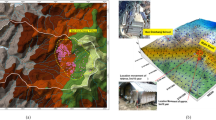Abstract
A slope stability analysis on a regional scale is presented for the northern part of the Rasuwa district in Nepal, covering 409 km2. A physically based slope stability model coupled to a simplified groundwater flow model was used to estimate soil wetness, and safety maps were generated for three steady state and two quasi-dynamic conditions. The results show that only about half of the soils are unconditionally stable, characterised by slopes smaller than 22°. Some 7% of the study area is prone to failure under completely saturated conditions, where the slopes exceed 30° and the land-use is predominantly agricultural. Some deficiencies in the model are discussed, but nevertheless the study shows that based upon relatively coarse and limited data, useful landslide hazard information on a regional scale can be obtained.
Résumé
Une analyse de stabilité des terrains est présentée à une échelle régionale, couvrant une surface de 409 km2, pour le nord du district de Rasuwa au Népal. Un modèle de stabilité des terrains, couplé à un modèle simplifié d'écoulement, a été utilisé pour estimer l'humidité des sols et générer des cartes d'aléa, avec trois conditions de régime permanent et deux conditions quasi dynamiques. Les résultats montrent que seulement la moitié de la région étudiée, présentant des pentes inférieures à 22°, n'est pas concernée par cet aléa. Environ 7% de la région présente des risques de glissements de terrain en conditions saturées, avec des pentes supérieures à 30° et un usage agricole des sols. Quelques défauts du modèle sont discutés. Cependant l'étude montre que, avec des données relativement simples et limitées, une information relative au risque de glissement de terrain peut être obtenue.










Similar content being viewed by others
References
Acharya G (2003) GIS approach for slope stability risk analysis: a case study from Nepal. MSc. Thesis, Physical Land Resources, Vrije Universiteit Brussel, p 114
Beven KJ, Kirkby MJ (1979) A physically based variable contributing area model of basin hydrology. Hydrol Sci Bull 24(1):43–49
Borga M, Dalla Fontana G, Da Ros D, Marchi L (1998) Shallow landslide hazard assessment using physically based model and digital elevation data. Environ Geol 35(2–3):81–88
Borga M, Dalla Fontana G, Cazorzi F (2002) Analysis of topographic and climatologic control on rainfall-triggered shallow landsliding using a quasi-dynamic wetness index. J Hydrol 268:56–71
Burton A, Bathurst JC (1998) Physically based modelling of shallow landslide sediment yield at a catchment scale. Environ Geol 35(2–3):89–99
Deoja BB, Dhital M, Thapa B, Wagner A (1991) Mountain risk engineering handbook. International Centre for Integrated Mountain Development (ICIMOD), Kathmandu p 875
de Vleeschauwer C (2001) The influence of groundwater on slope stability: a GIS approach, MSc thesis, Physical Land Resources, Vrije Universiteit Brussel, p 63
de Vleeschauwer C, De Smedt F (2002) Modeling slope stability using GIS on a regional scale. In: Proceedings of the first Geologica Belgica International Meeting, Leuven, 11–15 September 2002. Aardkundige Mededelingen, 12:253–256
Hoek E, Bray JW (1981) Rock slope engineering. The Institution of Mining and Metallurgy, London, p 358
Ingles OG, Metcalf JB (1972) Soil stabilization—principles and practice. Butterworth, Sydney, p 374
Kimothi MM, Juyal N (1996) Environmental impact assessment of few selected watersheds of Chamoli district (Central Himalaya) using remotely sensed data. Int J Remote Sens 17(7):1391–1406
Montgomery DR, Dietrich WE (1994) A physically based model for the topographic control on shallow landsliding. Water Resour Res 30(4):1153–1171
Pack RT, Tarboton DG, Goodwin CN (1998) The SINMAP approach to terrain stability mapping. In: Moore DP, Hungr O (eds) Proceedings—international congress of the International Association for Engineering Geology and the Environment 8, v. 2, A.A. Balkema, Rotterdam, Netherlands pp 1157–1165
Pack RT, Tarboton DG, Goodwin CN (2001) Assessing terrain stability in a GIS using SINMAP. In: 15th annual GIS conference, GIS 2001, Vancouver, British Columbia, February pp 19–22
Pathak S, Nilsen B (2004) Probabilistic rock slope stability analysis for Himalayan condition. Bull Eng Geol Environ 63:25–32
Skempton AW, DeLory FA (1957) Stability of natural slopes in London clay. In: Proceedings 4th international conference on Soil Mechanics and Foundation Engineering 2:378–391
Saha AK, Gupta RP, Arora MK (2002) GIS-based landslide hazard zonation in the Bhagirathi (Ganga) valley, Himalayas. Int J Remote Sens 23(2):357–369
Sarkar S, Kanungo DP (2004) An integrated approach for landslide susceptibility mapping using remote sensing and GIS. Photogramm Eng Remote Sens 70(5):617–625
Sidle RC (1991) A conceptual model of changes in root cohesion in response to vegetation management. J Environ Qual 20(1):43–52
Van Westen CJ, Terlien MTJ (1996) An approach towards deterministic landslide hazard analysis in GIS: a case study from Manizales (Colombia). Earth Surf Process Landforms 21:853–868
Wanielista M, Kersten R, Eaglin R (1997) Hydrology: water quantity and quality control. Wiley, New York, p 567
Author information
Authors and Affiliations
Corresponding author
Rights and permissions
About this article
Cite this article
Acharya, G., De Smedt, F. & Long, N.T. Assessing landslide hazard in GIS: a case study from Rasuwa, Nepal. Bull Eng Geol Environ 65, 99–107 (2006). https://doi.org/10.1007/s10064-005-0025-y
Received:
Accepted:
Published:
Issue Date:
DOI: https://doi.org/10.1007/s10064-005-0025-y




